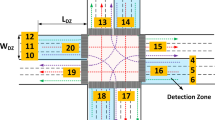Abstract
Planning so-called green waves along major road axes is a well-established target for traffic engineers. This is mainly for two reasons: a smooth traffic flow quality, and less air pollution. For one-way road axes (e.g., the Avenues in Manhattan), this is a trivial downstream task. For bidirectional arterials, there is a well-known necessary condition for establishing a green wave in both directions: The driving times between two subsequent crossings must be integer multiples of half of the cycle time of the signal programs at the nodes. In this presentation, we propose an integer linear optimization model to establish fixed-time green waves in both directions that are as long and as wide as possible, even in the situation where the above-mentioned driving time condition is not fulfilled. In particular, we are considering an arterial along whose nodes separate left-turn signal groups are realized. In our computational results, we show that scheduling left-turn phases before or after the straight phases can reduce waiting times along the arterial. Moreover, we show that there is always a solution with green waves in both directions that are as long and as wide as possible, where absolute priority is put on just one direction. Only when considering prioritized parts of a green band (e.g. some first few seconds), then an ideal green wave into one direction can provide suboptimal quality compared to optimizing both directions together. Finally, we validate the nominal solution quality according to the objective function values with the results of corresponding runs of the well-established traffic flow simulation tool SUMO.
Access this chapter
Tax calculation will be finalised at checkout
Purchases are for personal use only
Similar content being viewed by others
References
Deutsches Zentrum für Luft- und Raumfahrt (DLR) (2022) SUMO—Simulation of Urban Mobility (Version 1.4.0). https://www.eclipse.org/sumo/. Last accessed 2022/07/18
Forschungsgesellschaft für Straßen- und Verkehrswesen (FGSV). (2015). Handbuch für die Bemessung von Straßenverkehrsanlagen (HBS) – Teil S: Stadtstraßen. ISBN 978-3-8446-103-3. In German. FGSV-Verlag GmbH.
Köhler, E., & Strehler, M. (2015). Traffic signal optimization using cyclically expanded networks. Networks, 65(3), pp. 244–261.
Köhler, E., & Strehler, M. (2019). Traffic signal optimization: Combining static and dynamic models. Transportation Science, 53(1), 21–41.
Liebchen, Ch. (2006). Periodic timetable optimization in public transport. dissertation.de – Verlag im Internet.
Liebchen, Ch. (2022). Maximizing bidirectional green waves for major road axes. Preprint, Technische Hochschule Wildau. https://doi.org/10.15771/2827. Last accessed 2022/07/19
Serafini, P., & Ukovich, W. (1989). A mathematical model for periodic scheduling problems. SIAM Journal on Discrete Mathematics, 2(4), 550–581.
Wünsch, G. (2008). Coordination of traffic signals in networks. Ph.D. thesis, Technical University Berlin, Germany.
Zhang, C., Yuanchang, X., Gartner, N. H., Stamatiadis, Ch., & Arsava, T. (2015). AM-band: An asymmetrical multi-band model for arterial traffic signal coordination. Transportation Research Part C, 58, 515–531.
Author information
Authors and Affiliations
Corresponding author
Editor information
Editors and Affiliations
Rights and permissions
Copyright information
© 2023 The Author(s), under exclusive license to Springer Nature Switzerland AG
About this paper
Cite this paper
Liebchen, C. (2023). Bidirectional Green Waves for Major Road Axes by Adjusting Separate Left-Turn Phases. In: Grothe, O., Nickel, S., Rebennack, S., Stein, O. (eds) Operations Research Proceedings 2022. OR 2022. Lecture Notes in Operations Research. Springer, Cham. https://doi.org/10.1007/978-3-031-24907-5_59
Download citation
DOI: https://doi.org/10.1007/978-3-031-24907-5_59
Published:
Publisher Name: Springer, Cham
Print ISBN: 978-3-031-24906-8
Online ISBN: 978-3-031-24907-5
eBook Packages: Business and ManagementBusiness and Management (R0)




